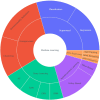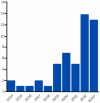From data to diagnosis: how machine learning is revolutionizing biomarker discovery in idiopathic inflammatory myopathies
- PMID: 38243695
- PMCID: PMC10796252
- DOI: 10.1093/bib/bbad514
From data to diagnosis: how machine learning is revolutionizing biomarker discovery in idiopathic inflammatory myopathies
Erratum in
-
Correction to: From data to diagnosis: how machine learning is revolutionizing biomarker discovery in idiopathic inflammatory myopathies.Brief Bioinform. 2024 Jan 22;25(2):bbae100. doi: 10.1093/bib/bbae100. Brief Bioinform. 2024. PMID: 38446744 Free PMC article. No abstract available.
Abstract
Idiopathic inflammatory myopathies (IIMs) are a heterogeneous group of muscle disorders including adult and juvenile dermatomyositis, polymyositis, immune-mediated necrotising myopathy and sporadic inclusion body myositis, all of which present with variable symptoms and disease progression. The identification of effective biomarkers for IIMs has been challenging due to the heterogeneity between IIMs and within IIM subgroups, but recent advances in machine learning (ML) techniques have shown promises in identifying novel biomarkers. This paper reviews recent studies on potential biomarkers for IIM and evaluates their clinical utility. We also explore how data analytic tools and ML algorithms have been used to identify biomarkers, highlighting their potential to advance our understanding and diagnosis of IIM and improve patient outcomes. Overall, ML techniques have great potential to revolutionize biomarker discovery in IIMs and lead to more effective diagnosis and treatment.
Keywords: biomarkers; idiopathic inflammatory myopathies; machine learning; myositis-specific autoantibodies.
© The Author(s) 2024. Published by Oxford University Press.
Figures





References
-
- Hočevar A, Rotar Z, Krosel M, et al. Performance of the 2017 European league against rheumatism/American College of Rheumatology Classification Criteria for adult and juvenile idiopathic inflammatory myopathies in clinical practice. Ann Rheum Dis 2018;77(12):e90. - PubMed
-
- Group F-NBW . Best (Biomarkers, Endpoints, and Other Tools) Resource. Silver Spring, Bethesda, Maryland: Food and Drug Administration (US) National Institutes of Health (US), 2016.
-
- Greenberg SA, Pinkus JL, Pinkus GS, et al. Interferon-alpha/beta-mediated innate immune mechanisms in dermatomyositis. Ann Neurol 2005;57(5):664–78. - PubMed
Publication types
MeSH terms
Substances
Grants and funding
LinkOut - more resources
Full Text Sources
Medical

